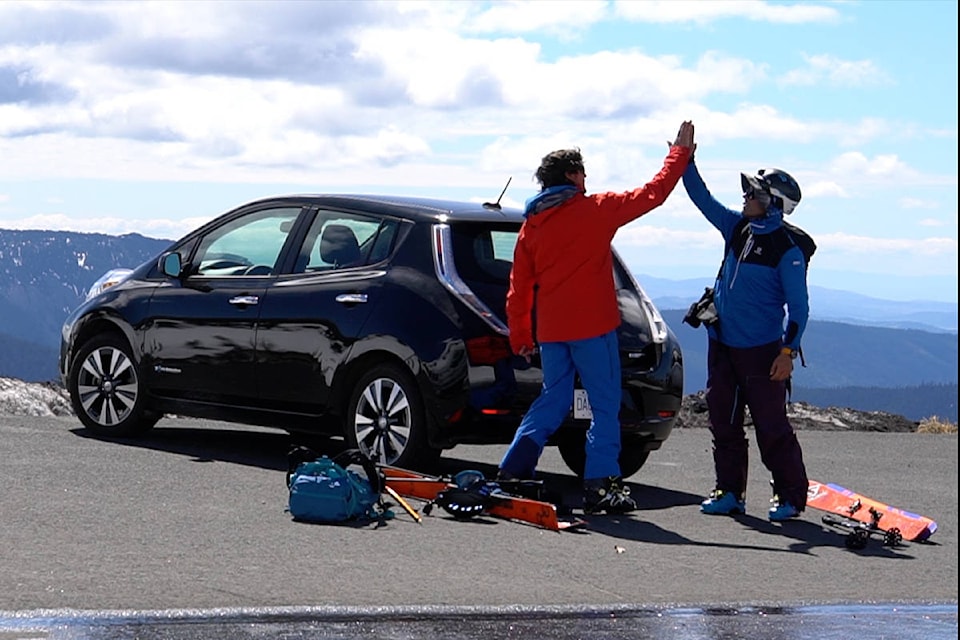By Greg Hill, Special to the Review
We are constantly reading about electric vehicles and how they are the future. Yet a part of me has been skeptical of the realistic usage of these cars. Up until now, most have had only a limited range, which makes them ideal commuter vehicles but useless for someone in Revelstoke who escapes to the cities frequently.
As explorers Chris Rubens and I went on an electric adventure. Our goal was to see if we could live our normal adventure-seeking lifestyle while being more sustainable in our mode of transport.
I rented a Nissan Leaf from Ecomoto in Vancouver. This car is a commuter vehicle with a 160 kilometre range. It is far from the ideal electric vehicle, but if we could drive down the west coast, climb and ski a bunch of volcanoes and make it back, we could prove to ourselves that electric access is the future. Especially with the newer, farther reaching cars, and snowmobiles!
We met up and climbed and skied Mt-Baker with a group of friends and then began our true road trip down south. An app called “Plug and Share” would guide us to all the level three chargers, which take around 40 minutes to fully charge the car. This trip was ideal since the I-5 highway that goes south through Washington, Oregon and into California was covered with these chargers.
Our first charging hurdle was getting up to Mt-Rainier. Since its trailhead is quite far inland and well away from any level three chargers. Luckily, our app showed us a level two charger that some guy, Phil, had attached to his house for his Tesla. We arrived at the park boundary and started charging at Phil’s personal plug. The percentage slowly moved upwards but we had to hastily leave with barely 70 per cent since the park’s gates were closing.
Committed we drove upwards. As we climbed up to the 2,000 metre trailhead our percentage dropped and dropped. 40 per cent… 35 per cent… Finally, at 31 per cent, we made it to the trailhead. We parked and decided to deal with this lack of electricity when we returned.
A great couple of days had us on the summit and then skiing down a heavily crevassed, super awesome run. Arriving back at the car we wondered if our first mistake was going to haunt us. Luckily the Leaf has a ‘B’ mode that allows the car to slow itself using the engine, which puts electricity back into the motor. We drove down the 1500 metre road and by the bottom our charge was back up to 50 per cent. Yeehaw! Maybe this electric adventure was feasible.
Mt. Hood was our next objective and there were level three chargers right up to its trailhead. A great summit and silly ski had us driving south. Eventually, the ease of charging had us pushing the battery percentage as low as we could go, extending each drive till the percentage disappeared and the kilometres left blinked out. We realized there was always extra battery left and we pushed it many times, never fully running out of juice.
We made it as far south as Mt. Shasta in California, where there were fewer level three chargers and we ended up charging up at RV campgrounds, which were level two chargers that would take three to five hours to fully charge. We were the oddball Canadians, camped amongst the behemoth RVs in our tiny Lead.
While we drove back north, hitting Mt. Adams on the way, we pondered our experiment. We ended up traveling almost 4,000 kilometres, we climbed and skied six volcanoes, we rock climbed five times, had some amazing adventures, and camped in great places. Essentially we lived our lives as we normally would, with one major difference — we used one litre of fuel during the whole trip, for our cookstove, instead of the 400-plus litres we would have normally used.
Not being able to move quickly between objectives, made us more relaxed. Forced stops every few hours had us rethinking our Type A personalities. To me, electric vehicles are the future, especially since climate change would affect our town so badly. I have ordered a Chevrolet Bolt, which has twice the distance per charge than the car we rented and makes everything realistic. A drive to Vancouver would mean a stop for a stretch, bike ride or a read in Meritt or Hope, but it would also mean less fossil fuel usage, less of a carbon footprint, and also it will cost approximately $10 for the drive instead of $90.
Electric charging stations in B.C.
By Alex Cooper
How feasible is it to go on a road trip from Revelstoke with an electric car? It depends on where you want to go and how much of a rush you’re in.
The website PlugShare.com, which is a wiki-style page where people can mark charging stations on a map, shows there’s a steady number of stations across southern B.C.
The map shows three in Revelstoke — the Tesla Superchargers at the Best Western Plus, the charger outside the visitor centre, and one at the Revelstoke Campground (formerly the KOA).
Heading east is trickier — the next possible spot to charge is the Camper Haven campground in Donald. After, there’s a charging station in Golden, and lots of spots to charge in Lake Louise, Banff and Canmore.
Heading west, the Malakwa Supermarket advertises a charger, and there’s places you can charge in Sicamous, Salmon Arm, Chase, Kamloops, Merritt and Hope. Once you hit the Fraser Valley, charging stations are plentiful. There’s also no shortage of them in the Okanagan.
Going south, there’s a dearth of charging stations until you reach the Nelson-Trail corridor.
If you’re heading to northern B.C., be warned there’s no high-power stations north of Kamloops. Surprisingly, there’s also no high-power stations between Calgary and Winnipeg.
